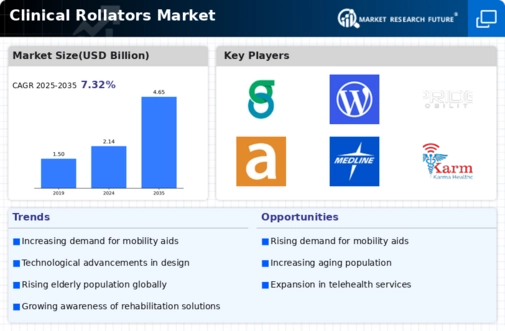Aging Population
The Global Clinical Rollators Market Industry experiences a notable driver in the increasing aging population. As individuals age, mobility challenges often arise, necessitating the use of assistive devices like rollators. By 2024, the market is projected to reach 2.14 USD Billion, reflecting the growing demand for mobility aids among seniors. This demographic shift indicates a potential increase in the prevalence of conditions such as arthritis and osteoporosis, further driving the need for rollators. The aging population not only influences market growth but also shapes product innovation, as manufacturers strive to meet the specific needs of older adults.
Technological Advancements
Technological advancements play a crucial role in shaping the Global Clinical Rollators Market Industry. Innovations such as lightweight materials, ergonomic designs, and integrated smart features enhance the usability and appeal of rollators. These advancements cater to the diverse needs of users, including those with varying levels of mobility impairment. As the market evolves, manufacturers are likely to invest in research and development to create more sophisticated products. The anticipated growth from 2.14 USD Billion in 2024 to 4.65 USD Billion by 2035 underscores the importance of technology in driving market expansion and meeting consumer expectations.
Government Initiatives and Funding
Government initiatives and funding programs aimed at improving healthcare accessibility significantly influence the Global Clinical Rollators Market Industry. Many countries are implementing policies to support the elderly and individuals with disabilities, including subsidies for mobility aids. Such initiatives not only enhance access to rollators but also encourage manufacturers to expand their offerings. As governments prioritize healthcare funding, the market is likely to benefit from increased investment in assistive technologies. This supportive environment fosters innovation and competition, ultimately leading to a broader range of options for consumers and contributing to market growth.
Increased Awareness and Acceptance
Increased awareness and acceptance of mobility aids contribute significantly to the Global Clinical Rollators Market Industry. Educational initiatives by healthcare providers and advocacy groups promote the benefits of using rollators, leading to a shift in public perception. As more individuals recognize the importance of maintaining mobility, the demand for rollators is likely to rise. This trend is particularly evident in rehabilitation settings, where healthcare professionals encourage the use of assistive devices to enhance recovery. The growing acceptance of rollators as essential tools for independence and mobility is expected to drive market growth in the coming years.
Rising Incidence of Chronic Diseases
The prevalence of chronic diseases significantly impacts the Global Clinical Rollators Market Industry. Conditions such as diabetes, cardiovascular diseases, and respiratory disorders often lead to reduced mobility, prompting individuals to seek mobility aids. The market is expected to grow at a CAGR of 7.3% from 2025 to 2035, indicating a sustained demand for rollators as more individuals require assistance in daily activities. Healthcare systems worldwide are increasingly recognizing the importance of mobility aids in improving the quality of life for patients with chronic conditions. This trend not only drives sales but also encourages innovation in rollator design and functionality.

















Leave a Comment